Chapter 5 Internal Resources, Capabilities and Competences
LEARNING OBJECTIVES 1. Discriminate between strategic capability, threshold resources, threshold competences, unique resources and core competences. |
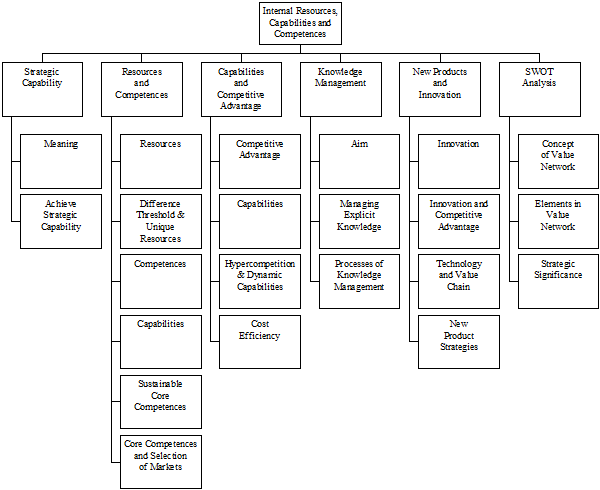
1. Strategic Capability
1.1 The meaning of strategic capability
1.1.1 Strategic capability means the ability of an entity to perform and prosper, by achieving strategic objectives. It can also be described as the ability of an organisation to use its core competences to create competitive advantage.
1.1.2 Previous chapters have described the environment of an entity, and how an entity can succeed by exploiting opportunities and dealing with threats that emerge in the environment.
1.1.3 However, monitoring the environment for opportunities and threats is not sufficient to provide an entity with competitive advantage. Strategic capability comes from competitive advantage. Competitive advantage comes from the successful management of resources, competences and capabilities.
1.2 Achieving strategic capability
1.2.1 A resource-based view of the firm is based on the view that strategic capability comes from competitive advantage, which comes in turn from the resources of the firm and the use of those resources (competences and capabilities).
1.2.2 This is illustrated in the following hierarchy of requirements for strategic capability.
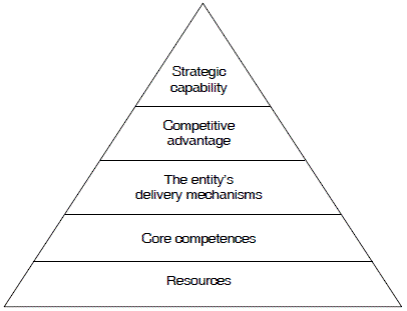
2. Resources and Competences
2.1 Resources
2.1.1 An entity uses resources to provide products or services to its customers. A resource is any asset, process, skill or item of knowledge that is controlled by the entity.
2.1.2 Resources can be grouped into categories:
(a) Human resources. These are the leaders, managers and other employees of an entity, and their skills.
(b) Physical resources. These are the tangible assets of an entity, and include property, plant and equipment, and also access to sources of raw materials.
(c) Financial resources. These are the financial assets of the entity, and the ability to acquire additional finance if this is required.
(d) Intellectual capital. This includes resources such as patents, trademarks, brand names and copyrights. It also includes the acquired knowledge and ‘know-how’ of the entity.
2.2 Difference between threshold (門檻,起點) resources and unique resources
2.2.1 Threshold resources are the resources that an entity needs in order to participate in the industry and compete in the market. Without threshold resources, an entity cannot survive in its industry and markets.
2.2.2 Unique resources are resources controlled by the entity that competitors do not have and would have difficulty in acquiring. Unique resources can be a source of competitive advantage.
2.2.3 A unique resource is a resource that competitors would have difficulty in acquiring. It might be obtained from:
(a) ownership of scarce raw materials, such as ownership of exploration rights or mines
(b) location: for example a hydroelectric power generating company benefits from being located close to a large waterfall or dam, and a bank might benefit from a city centre location
(c) a special privilege, such as the ownership of patents or a unique franchise.
2.2.4 Unique resources are a source of competitive advantage, but they can change over time. They can lose their uniqueness. For example:
(a) An investment bank might benefit from employing an exceptionally talented specialist; however, a rival bank might ‘poach’ him and persuade him to join them.
(b) A company might have patent rights that prevent competitors from copying a unique feature of a product that the company produces. However, competitors might find an alternative method of making a similar product, without infringing the patent rights.
2.3 Competences
2.3.1 Competences are activities or processes in which an entity uses its resources. They are created by bringing resources together and using them effectively. Competences are used to provide products or services, which offer value to customers.
2.3.2 A competence can be defined as an ability to do something well. A business entity must have competences in key areas in order to compete effectively.
2.3.3 Threshold competences are activities, processes and abilities that provide an entity with the capability to provide a product or service with features that are sufficient to meet customer needs (the ability to provide ‘threshold’ product features).
2.3.4 Core competences are activities, processes and abilities that give the entity a capability of meeting the critical success factors for products or services, and achieving competitive advantage.
2.3.5 The concept of core competence was first suggested in the 1990s by Hamel and Pralahad, who defined core competence as: ‘Activities and processes through which resources are deployed in such as way as to achieve competitive advantage in ways that others cannot imitate or obtain.’
2.4 Capabilities
2.4.1 Threshold capabilities are the minimum capabilities needed for the organisation to be able to compete in a given market. For example, threshold competencies are competencies:
(a) where the entity has the same level of competence as its competitors, or
(b) that are easy to imitate.
2.4.2 To do really well, however, an entity needs to do more than merely to meet thresholds; it needs capabilities for competitive advantage. Capabilities for competitive advantage consist of core competences. These are ways in which an entity uses its resources effectively, better than its competitors, and in ways that competitors cannot imitate or obtain.
2.5 Sustainable core competences
2.5.1 Core competences might last for a very short time, in which case they do not provide much competitive advantage.
2.5.2 Competitive advantage is provided by sustainable core competences. These are core competences that can be sustained over a fairly long period of time – over a period of time that is long enough to achieve strategic objectives.
2.5.3 Sustainable competences should be durable and/or difficult to imitate.
(a) Durability. Durability refers to the length of time that a core competence will continue in existence, or the rate at which a competence depreciates or becomes obsolete.
(b) Difficulty to imitate. A sustainable core competence is one that is difficult for competitors to imitate, or that it will take competitors a long time to imitate or copy.
2.6 Core competences and the selection of markets
2.6.1 A core competence gives a business entity a competitive advantage in a particular market or industry.
2.6.2 Some strategists have taken the idea of core competence further. They argue that if an entity has a particular core competence, the same competence can be extended to other markets and other industries, where they will be just as effective in creating competitive advantage.
2.6.3 An entity should therefore look for opportunities to expand into other markets where it sees an opportunity to exploit its core competences.
2.6.4 |
Example 1 |
|
The Marriot group is well known as a chain of hotels. However, the group developed a range of different services based on the core competencies it acquired from operating a chain of hotels. It extended these competencies successfully into markets such as conference organisation, hospitality arrangements at events (for example at sporting events) and facilities management. |
2.7 Summary: resources and competences
2.7.1 Resources and competences are necessary to compete in a market and deliver value to the customer. Unique resources and core competences are needed to create competitive advantage.
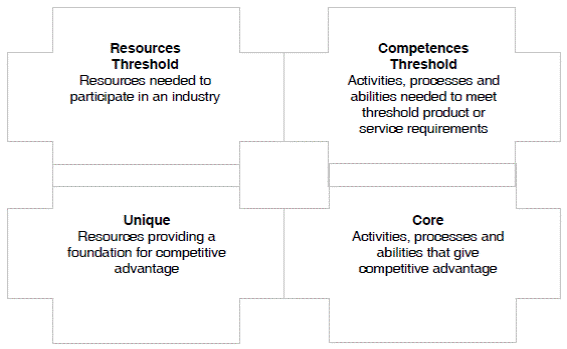
2.7.2 Threshold resources and competences are necessary, but are not sufficient for achieving strategic success (strategic capability).
3. Capabilities and Competitive Advantage
3.1 Competitive advantage
3.1.1 Competitive advantage is any advantage that an entity gains over its competitors, that enables it to deliver more value to customers than its competitors. Competitive advantage is essential for sustained strategic success.
3.1.2 The result of competitive advantage should be an ability to:
(a) create added value in products or services, that customers will pay more to obtain, or
(b) create the same value for customers, but at a reduced cost.
3.2 Capabilities
3.2.1 Capabilities are the ability to do something. An entity should have capabilities for gaining competitive advantage. These come from using and coordinating the resources and competences of the entity to create competitive advantage. Capabilities arise from a complex combination of resources and core competences, and they are unique to each business entity.
3.2.2 If strategy is to be based on strategic capabilities, those capabilities must have four qualities.
(a) Value to buyers
(b) rarity
(c) Robustness (difficult for competitors to imitate)
(d) non-substitutability
(a) Value to buyers
3.2.3 The strategic capability must be one that is of value to the customer. A distinctive capability is not enough: the strategic capability must be able to generate what customers value in terms of products or services.
(b) Rarity
3.2.4 Competitive advantage will not be attained if competitors have identical strategic capabilities. Unique or rare resources or competences are needed to allow the organisation to outperform its rivals.
(c) Robustness
3.2.5 Capabilities for competitive advantage should be robust, meaning that they are hard to imitate. Therefore, competitive advantage is not so often sustained through physical/tangible resources as these can be copied/acquired over time. More important is the way in which the resources are organised and deployed as these competences are, in general, more difficult to identify and imitate.
(d) Non-substitutability
3.2.6 Substitutability of strategic capability has two forms and managers must be alert to the emergence of either, since both are a threat to even a competence that possesses the other three vital qualities.
(a) The substitute product you are familiar with from out earlier discussion of the five forces.
(b) The substitute competence: an example is the deployment of expert systems as substitutes for expensive professional advisers.
3.2.7 |
Example 2 |
|
Panasonic and Leica formed a joint venture to produce cameras under the trade name ‘Lumix’. How did this enable the companies to gain both threshold and capabilities for competitive advantage? Leica was a very famous and prestigious conventional camera maker, esteemed for the quality of its lenses; it had no electronics capability. Panasonic has immense electronics design and production capability; it has (or had) no optical capability. Together the partners gained threshold capability in making high quality digital cameras – good lenses and good electronics. It’s not clear if the joint venture has generated capabilities for competitive advantage. Certainly both partners have strong, respected brand names, but other companies (such as Sony and Canon) are very strong in the digital camera market also. It has yet to be seen if Lumix will enjoy protection from competitors that will allow long term competitive advantage. |
3.2.8 |
Example 3 |
|
In terms of margin per unit sold, Porsche is the world’s most successful car company. Suggest how that company might have achieved and sustained such a strong position. Value – many people value a well styled, prestigious, well built, High performance sports car. |
3.3 Hypercompetition and dynamic capabilities
3.3.1 The nature of the strategic capabilities is that they are long-term phenomena: tangible and intangible resources will be more valuable if they can be counted on to last a long time, while the development of core competences might well be expected to be a fairly protracted process.
3.3.2 Under conditions of hypercompetition, strategic capability takes a different form. In order to deal with the rapid market changes seen under conditions of hypercompetition, firms must possess dynamic capabilities.
3.3.3 Dynamic capabilities are an organization’s abilities to develop and change competences to meet the needs of rapidly changing environments.
3.3.4 Such capabilities demand the ability to change, to innovate and to learn. They can take many forms and may include such things as systems for new product development or the acquisition of market intelligence and the absorption of new skills and products acquired by merger or acquisition.
3.4 Cost efficiency and strategic capability
3.4.1 Porter has argued that in order to achieve strategic capability, an entity must gain competitive advantage over its rivals, and competitive advantage can be achieved by adding value or by reducing costs.
3.4.2 Cost efficiency to an accountant means minimising costs through control over spending and the efficient use of resources. A firm must achieve a certain level of cost efficiency if it is to be able to compete and survive in the industry. In strategic management, cost efficiency refers to the ability not only to minimise costs in current conditions, but to continually reduce costs over time.
3.4.3 The ability to reduce costs continually is often a key requirement for strategic success. Cost efficiency has been described as a ‘threshold strategic capability’. A cost efficiency capability is the result of both:
(a) making better use of resources or obtaining lower-cost resources, and
(b) improving competencies and capabilities (for example, improving the systems of inventory management).
3.4.4 Ways of achieving cost efficiency:
(a) economies of scale – it refers to ways in which the average costs of production can be reduced by producing or operating at a higher volume of output.
(b) economies of scope – in some industries, reductions in costs might be achieved by producing two or more products, so that an entity that makes all the products achieves lower costs per unit than competitors that produce only one of the products.
(b) experience (the learning curve)
(c) supply and production costs
(d) product/process design
3.4.5 Cost efficiency can become a strategic capability, which will give the organization competitive advantage, for example by achieving ‘cost leadership’.
3.4.6 |
Example 4 |
|
Economies of scale It achieves lower costs by exploiting economies of scale. It can buy raw materials (such as bricks and windows) at lower prices by purchasing in bulk. It can make better use of the time of its specialised workers. It can also reduce costs by buying its own construction equipment, instead of having to hire equipment from equipment suppliers at a higher cost (which is what Company A must do). Economies of scope Company D might be able to achieve greater cost efficiencies than either Company D or Company E because it produces both curtains and carpets, and not just one product. |
Question 1 (a) Firespeed, offering high product quality, at a price which offers good value for money. FTL has a good relationships with car firms and distributors. GTC is rather less focused: not only does it make tyres and some other components, but it also owns a chain of car service centres specializing in minor maintenance matters such as tyre replacement, exhaust fitting, and wheel balancing. FTL has experienced a fall in sales volume, partly as a result of competition from overseas producers, in what is effectively a mature market. Moreover, sales of new cars have not been as high as had been hoped, and consumers are more reluctant than before to part with their money. FTL’s managers have had meetings with GTC’s managers as to how to revive (復甦) the fortunes of the company. FTL would like to export to the US and to Asia. GTC has vetoed (否決) this suggestion, as FTL’s tyres would compete with GTC’s. Instead, GTC suggests that FTL imitate GTC’s strategy by running a chain of service stations similar to GTC’s service stations in the US. GTC feels that vertical integration would offer profits in its own right and provide a distribution network which would reduce the impact of competition from other tyre manufacturers. GTC has no shortage of cash. You are a strategic consultant to FTL. Required: (a) Discuss the principal factors in the external environment that would influence FTL’s strategic choice. (6 marks) |
4. Knowledge Management
4.1 Aim of knowledge management
4.1.1 The aim of knowledge management is to capture, organize and make widely available all the knowledge the organization possesses, whether explicit (in recorded form) or tacit (in people’s heads).
4.2 Managing explicit knowledge
4.2.1 Data are simple facts that can be organized in a way that creates information. Knowledge is patterns of information that are strategically useful and context independent.
4.2.2 There is an important conceptual hierarchy underpinning knowledge management. This distinguishes between data, information and knowledge. The distinctions are not clear-cut and, to come extent, are differences of degree than kind.
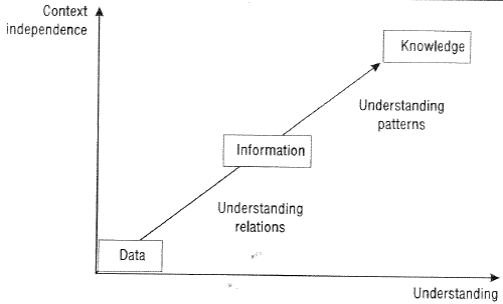
4.2.3 |
Example 5 |
|
Members of a sales team will have information available about the sales made to key customers and the sales trends of the company’s major products. This information and knowledge is explicit as it exists in reports that are widely distributed. A sales representative may have personal knowledge about the character, interests and background of the buyers in major customers. This helps the sales person get on with the buyers and this should help to generate sales. If the sales representative keeps this knowledge to himself, or herself, this would be an example of tacit knowledge and the organisation will not usually be aware of it. Indeed, the sales representative might not be actively aware about the importance of this knowledge and about how it is used in the sales process. Another sales representative has read an article in a scientific journal that implies that one of the company’s major products may have long term health implications for customers. However, that knowledge remains tacit unless passed on to others and formalised. |
4.3 Processes of knowledge management
4.3.1 Knowledge management is the process by which organizations generate value from their intellectual and knowledge-based assets. This involves:
(a) discovering or identifying knowledge
(b) capturing knowledge
(c) sharing knowledge
(d) distributing knowledge
(e) using knowledge
(f) maintaining knowledge
4.3.3 In effect, knowledge management has three phases: capture, record and disseminate.
4.3.4 Knowledge management is becoming increasingly important in helping organizations sustain competitive advantage.
4.3.5 As organizations become more complex, there is more knowledge to manage. Moreover the importance of capturing and sharing it is increased as job mobility increases. If staff leave, there is a danger knowledge could leave with them, if it has not been properly managed within the organization.
4.3.6 Also organizations’ external environments – technology, competitors, markets – are changing rapidly so organizations need to ensure they have up-to-date knowledge about these external factors to take account of the opportunities and threats they represent.
4.3.7 |
Example 6 |
|
Modern IT systems have made sharing and distributing knowledge easier. Corporate intranets will make available information on customers and products. Groupware, such as Lotus Notes, allows collaboration on documents and projects, customer relationship management systems provide quick access to important customer information and can provide customers with a much better service. The UK Government has a massive project in progress to computerize everyone’s health records. The aim is that a patient’s medical history will be available instantly to any health professional in any hospital or clinic. |
5. New Products and Innovation
5.1 Innovation
5.1.1 Innovation can be a major source of competitive advantage but brings a burden of cost and uncertainty. To avoid waste, there should be a programme of assessment for major product development. The firm must decide whether to be a leader or a follower.
5.1.2 Innovation is increasingly seen as important for strategic success. The reasons are:
(a) increased rate of technical advances
(b) increased competition
(c) increased customer expectations.
5.2 Innovation and competitive advantage
5.2.1 For many organizations, product innovation and being the first mover may be a major source of competitive advantage.
(a) A reputation for innovation will attract early adopters, though it depends in part on promotional effort.
(b) Customers may find they are locked in to innovative suppliers by unacceptable costs of switching to competitors.
(c) The learning (or experience) curve effect may bring cost advantages.
(d) The first mover may be able to define the industry standard.
(e) A price skimming strategy can bring early profits that will be denied to later entrants.
(f) Legal protection, such as patents, for intellectual property may bring important revenue advantages. This is particularly important in the pharmaceutical industry.
5.2.2 Of course, the first mover also has particular problems:
(a) gaining regulatory approval where required
(b) uncertain demand
(c) high levels of R&D costs
(d) low cost imitators
(e) costs of introduction such as training sales staff and educating customers.
5.3 Technology and the value chain
5.3.1 Porter points out in Competitive Advantage that “every value activity uses some technology to combine purchased inputs and human resources too produce some output.”
5.3.2 Improvement in the linkages of the value chain will enhance competitive advantage.
5.3.3 |
Example 7 – The importance of innovation |
|
Amazon first appeared on the internet in 1995 selling books. It was a major innovator in the business of internet retailing and soon CDs and DVDs were added to its product lists. The website allows customers to search a very extensive database and to order goods, which would normally be delivered by post in a few days. The website also allows customers to write reviews about products, and informs customers about how consumers of a particular product also bought other products. Consumer goods such as electronics are now available from Amazon. Although Amazon is preeminent in internet based sales of books, CDs and DVDs, innovation cannot stop and the company is spending heavily on technology that will allow customers to download books, music and video over the internet rather than having them delivered by post. The company is being forced to innovate because competitors, such as Apple’s iTunes, have been very successful in selling audio downloads, and have recently made movies available for downloading. On demand printing of books is particularly suitable for lower volume books and those that would normally be regarded as out of print. Unless Amazon can provide downloadable material, it risks losing business to those who can – rather like a decade ago when Amazon itself attacked conventional book and music shops. |
5.4 New product strategies
5.4.1 The development of new products might be considered an important aspect of a firm’s competitive and marketing strategies.
(a) New and innovative products can lower entry barriers to existing industries and markets, if new technology is involved.
(b) The interests of the company are best met with a balanced product portfolio. Managers therefore must plan when to introduce new products, how best to extend the life of mature ones and when to abandon those in decline.
5.4.2 A strategic issue managers must consider is their approach to new product development.
(a) Leader strategy. Do they intend to gain competitive advantage by operating at the leading edge of new developments? There are significant implications for the R&D activity and the likely length of product life cycles within the portfolio if this strategy is adopted. Also, R&D costs are likely to be heavy, with a significant reduction in potential profitability as a result.
(b) Follower strategy. Alternatively they can be more pro-active, adopt a follower strategy, which involves lower costs and less emphasis on the R&D activity. It sacrifices early rewards of innovation, but avoids its risks. A follower might have to license certain technologies from a leader. However, research indicates that this can be a more profitable strategy than being an innovator, especially when the follower is able to learn from the leader’s mistakes.
6. SWOT Analysis (TOWS Matrix)
6.1 Introduction
6.1.1 The SWOT analysis combines the results of the environmental analysis and the internal appraisal into one framework for assessing the firms’ current and future strategic fit, or lack of it, with the environment. It is an analysis of the organization’s strengths and weaknesses, and the opportunities and threats offered by the environment.
6.2 Using SWOT analysis
6.2.1 Effective SWOT analysis does not simply require a categorization of information, it also requires some evaluation of the relative importance of the various factors under consideration.
(a) These features are only of relevance if they are perceived to exist by the consumers. Listing corporate features that internal personnel regard as strengths/weaknesses is of little relevance if they are not perceived as such by the organization’s consumers.
(b) In the same vein, threats and opportunities are conditions presented by the external environment and they should be independent of the firm.
6.2.2 The SWOT can now be used guiding strategy formulation.
(a) Match strengths with market opportunities
Strengths that do not match any available opportunity are of limited use while opportunities which do not have any matching strengths are of little immediate value.
(b) Conversion
This requires the development of strategies that will convert weaknesses into strengths in order to take advantage of some particular opportunity, or converting threats into opportunities which can then be matched by existing strengths.
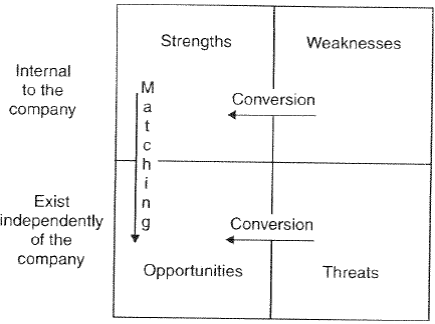
6.3 Weirich’s TOWS matrix
6.3.1 Weirich, one of the earliest writers on corporate appraisal, originally spoke in terms of a TOWS matrix in order to emphasis the importance of threats and opportunities. This is therefore an inherently positioning approach to strategy. A further important element of Weirich’s discussion was his categorization of strategic options;
(a) SO strategies employ strengths to seize opportunities.
(b) ST strategies employ strengths to counter or avoid threats.
(c) WO strategies address weaknesses so as to able to exploit opportunities.
(d) WT strategies are defensive, aiming to avoid threats and the impact of weaknesses.
6.3.2 One useful impact of this analysis is that the four groups of strategies tend to relate well to different time horizons. SO strategies may be expected to produce good short-term results, while WO strategies are likely to take much longer to show results. ST and WT strategies are more probably relevant to the medium term.
6.3.3 This consideration of time horizon may be linked to the overall resource picture: SO strategies can be profitable in the short term, generating the cash needed for investment in WO strategies, improving current areas of weaknesses so that further opportunities may be seized. ST and WT strategies are likely to be more or less resource-neutral, but care must be taken to achieve an overall balance.
6.3.4 |
Example 8 |
||||||||
|
What types of strengths, weaknesses, opportunities and threats would a ‘no frills’ (不提供非必要服務的) airline have?
|
Source: https://hkiaatevening.yolasite.com/resources/P3BANotes/Ch5-InternalCapability.doc
Web site to visit: https://hkiaatevening.yolasite.com
Author of the text: indicated on the source document of the above text
If you are the author of the text above and you not agree to share your knowledge for teaching, research, scholarship (for fair use as indicated in the United States copyrigh low) please send us an e-mail and we will remove your text quickly. Fair use is a limitation and exception to the exclusive right granted by copyright law to the author of a creative work. In United States copyright law, fair use is a doctrine that permits limited use of copyrighted material without acquiring permission from the rights holders. Examples of fair use include commentary, search engines, criticism, news reporting, research, teaching, library archiving and scholarship. It provides for the legal, unlicensed citation or incorporation of copyrighted material in another author's work under a four-factor balancing test. (source: http://en.wikipedia.org/wiki/Fair_use)
The information of medicine and health contained in the site are of a general nature and purpose which is purely informative and for this reason may not replace in any case, the council of a doctor or a qualified entity legally to the profession.
The texts are the property of their respective authors and we thank them for giving us the opportunity to share for free to students, teachers and users of the Web their texts will used only for illustrative educational and scientific purposes only.
All the information in our site are given for nonprofit educational purposes